Direct numerical simulations (bottom) of forced turbulence from the Johns Hopkins repository reveal patterns of intense vorticity (Leonard 2013, Journal of Cosmology Volume 22, APS/DFD meeting) matching the Planck Collaboration temperature anomalies observed by the Herschel space observatory in the cosmic microwave background (CMB) nine year average (upper right image). Thus the CMB "acoustic peak" has nothing to do with acoustic oscillations of plasma in cold dark matter potential wells (the LCDMHC model), but represents a universal turbulence generation pattern at Kolmogorov scales with one large and two small spectral peaks (upper left, Gibson 1996). Intense local inertial vortex forces stretch both primary and secondary turbulent vortices. Secondary vortices at right angles to each other are indicated by dashed lines (the HGD cosmology model). This generic driving structure for turbulent flows occupies a small fraction (~ 10^-5) of Kolmogorov space-time that decreases as the Reynolds number increases. Large negative pressures are produced at the vorticity maximum. According to Einstein's general relativity equations, mass-energy is extracted from the vacuum when the negative pressure magnitude exceeds ~ 10^113 Pa, which is the Fortov-Kerr value expected (c^7 h^-1 G^-2) from Planck scale fluid mechanics (CHG).
Illustration modified from that in Volume 22 to emphasize that the key difference between LCDMHC and HGD cosmologies is Life.
Life is inevitable in HGD cosmology because earth-mass planets dominate the mass of galaxies, as first observed by Schild (1996) and predicted by Gibson (1996),
and explain how life began and is propagated by Hoyle-Wickramasinghe cometary panspermia. Life is virtually impossible by the LCDMHC scenario,
where the first stars, and later the first planets, require > 300 Myr of "Dark Ages". By this time (~ 1 Gyr), the temperature (~ 10 K) and
density (~ 10^-26 kg/m^3) of the universe have decreased to such small values that life is impossibly rare and hopelessly isolated (CHG).
A remarkable series of meteorites in Sri Lanka containing extraterrestrial life confirm the Hoyle-Wickramasinghe
and water oceans at 2 Myr could not possibly have developed by Old Cosmology with its >400 Myr of dark ages.
These first cometary panspermia observations suggest the dark matter planets of New (HGD) Cosmology. A new scenario
Large luminosity and high temperatures are no longer interpreted as due to large mass stars, but to large rates of planet
accretion. Rapid planet accretion rates mix away the carbon cores of white dwarf stars permitting elements up to iron and
nickel to form, giving neutron stars and supernovae class II. The complexity of RNA-DNA requires the deep hot water
oceans and early cosmic mixing mechanisms provided by cometary panspermia and the biological big bang. See: eg
The original version of this paper was published in the Chinese Journal of Oceanology and Limnology, Vol. 22, No. 1, pp 1-23, 2004 after rejection by all US/UK fluid mechanics and oceanographic journals tested (JPO, JGR, JFM, etc.), whose referees and editors could not bring themselves to publish such radical new ideas about turbulence, fossil turbulence etc., even backed by this first publication of the RASP (2002, 2003) sea tests. The CJOL reprints available on line (Springer) are nearly illegible (CHG).
Estimates (Fig. 3: from Herschel and Planck space telescope data) ~ 10^5 PGCs exist in each of the LMC and SMC (large and small Magellanic cloud) clumps of these clumps of dark matter planets (CHG).
The SMC and LMC galaxies are both ~ 10^20 m clumps of frozen dark matter PGCs diffused from the protogalaxy, retaining their Nomura scale (10^20 m) protogalaxy sizes. The PGC objects (red dots) were invisible before infrared space telescopes Herschel and Planck were placed in orbit at the second Lagrange point by ESA in May 2009. The existence of ~ 10^17 dark matter planets in each of the LMC and SMC galaxies supports HGD cosmology, and falsifies LCDMHC cosmology. These exoplanets merge to form larger planets and stars, and form thick water layers from the star dust of supernovae to create organic chemistry and life on the hot primordial planets and the mechanism of Hoyle-Wickramasinghe cometary panspermia. See papers 9 and 10 below by G. Levin, whose careful experiments on Viking Landers first demonstrated the existence of water and life on Mars in 1976 (CHG, NCW).
Professor Walker reviews the history of dSph discoveries, from classic (pre SDSS) to recent "ultrafaint" Milky Way satellites that appear to be isolated PGCs (see figure).
Harvard Self Interacting Dark Matter Workshop, Aug. 7-9, 2013, tries to understand remarkable departures of observations from predictions of LCDMHC cosmology.
The opening speaker is Michael Boylan-Kolchin (Maryland), formerly from the University of California, Irvine. One of his recent preprints is "The Milky Way's bright satellites as an apparent failure of LambdaCDM". Self Interacting (nonbaryonic) Cold Dark Matter is self contradictory. If galactic (NB) dark matter is relatively collisionless compared to baryons, it will diffuse away from galaxies to form galaxy cluster halos, as shown by HGD cosmology. The evidence for SI(NB)DM is very weak. The concept has no physical basis, as shown in a preprint by Matthew G. Walker. The SIDM of galaxies is mostly baryonic, consisting of 10^36 kg PGC clumps of earth-mass gas planets, as observed by Schild (1996) and predicted from fluid mechanics by Gibson (1996). The dSph galaxies of the Milky Way became collisionless when their planets froze, and diffused outwards from the protogalaxy, as shown in the frontisepiece of Volume 18 of the Journal of Cosmology, not inwards as claimed by LCDMHC (CHG).
>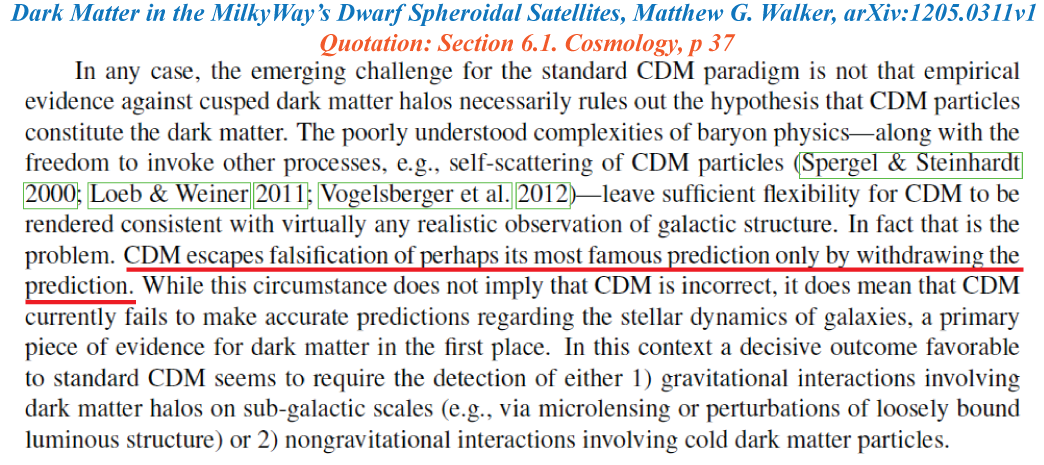
In his excellent review of dSph observations, Walker notes that the most dim dSphs are the most interesting. This is because they are PGCs (proto-globular-star-clusters) according to the HGD cosmology of Gibson (1996) and Schild (1996); that is, dense clumps of frozen gas planets that comprise the dark matter of galaxies. See his Figure 17:
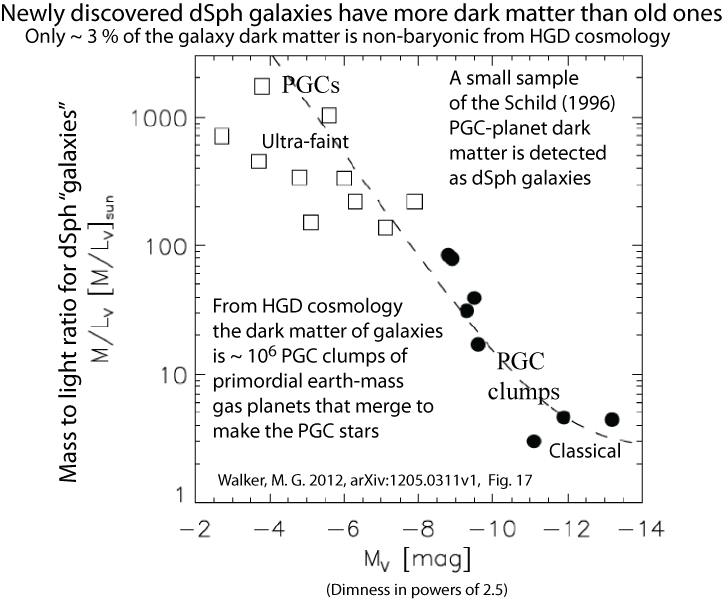
which shows the Ultra-faint dSph (dwarf spherical) galaxies have mass to light ratios that exceed 1000, as HGD cosmology predicts for PGCs with few stars. This is also shown in Walker's Figure 13:
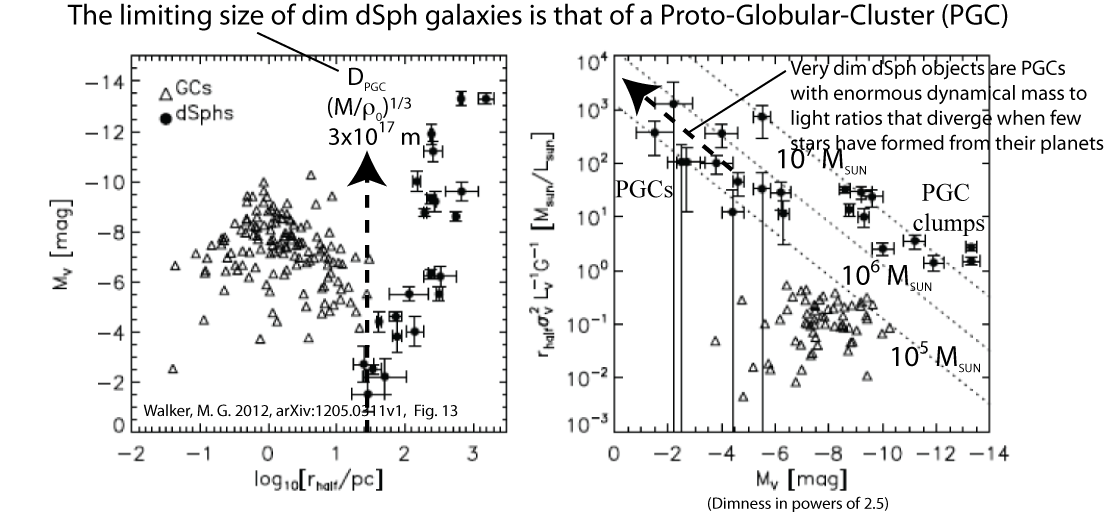
where the limiting size of globular-star-clusters (GCs) matches the size of PGCs (3x10^17 meters) on the left. The divergence of the dynamical mass to light ratio shown on the right of the figure is expected for dim PGCs with few stars formed by planet mergers.
More globular-star-clusters appear in superclusters like Abell 1689 than in the Milky Way, as shown by Alamo-Martinez et al. (2013). The GCs and the PGCs retain the same mass density as the supercluster at the time of its viscous-gravitational fragmentation during the plasma epoch at 10^12 seconds (30,000 years), as shown in the following figure. Note that the initial proto-supercluster size ~ 10^20 m (yellow dot) is too small to be shown. The initial plasma density ~ 4x10^-17 kg m^-3 is retained by the PGC clumps of planets and the GCs as a fossil of the plasma fragmentation. The homogeneous spherical-symmetry of the GCs in the Abell 1689 supercluster falsifies the fundamental LCDMHC mechanism of hierarchical clustering, which should produce inhomogeneous, asymmetrical, GC distributions on supercluster scales (CHG).
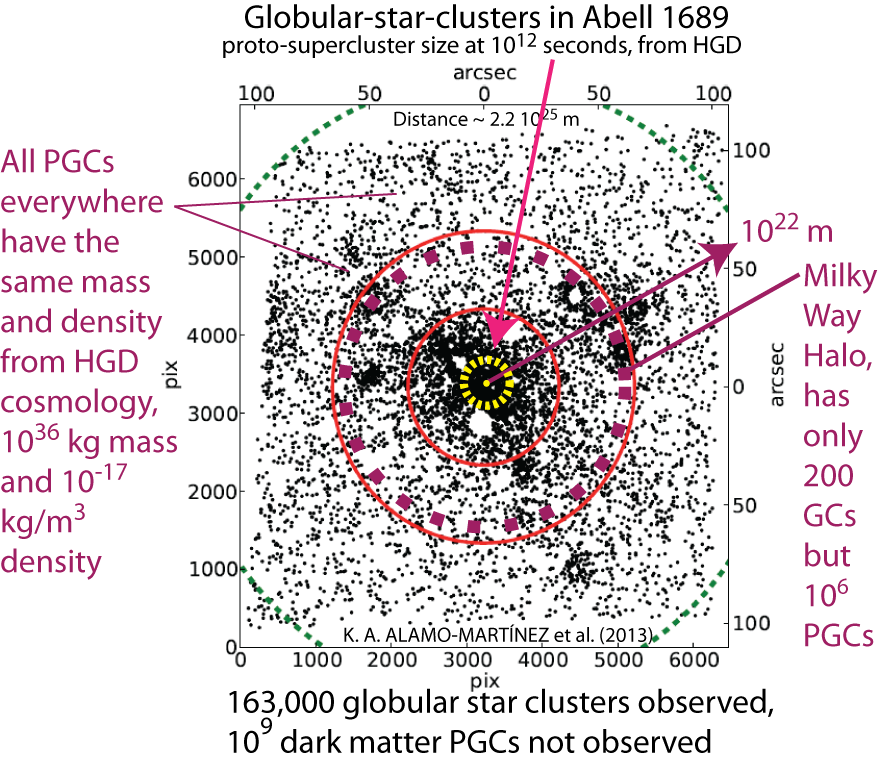
The inspiration for much of the work on Self-Interacting-Cold-Dark-Matter is the arXiv preprint of Spergel and Steinhardt (1999).
Bolyan-Kolchin: The end of the road for LCDMHC? , The Milky Way's bright satellites as an apparent failure of LCDM, Michael Boylan-Kolchin, James S. Bullock and Manoj Kaplinghat, "We use the Aquarius simulations to show that the most massive subhalos in galaxy-mass dark matter halos in LCDM are grossly inconsistent with the dynamics of the brightest Milky Way dwarf spheroidal galaxies. ...", Presentation.
Bullock: Solving Too Big to Fail: Baryonic or Dark Matter Physics?
Rocha: Solving Too Big to Fail: Baryonic or Dark Matter Physics?
Brooks: Baryons matter: Interpreting our Cosmological Model
Hai-Bo Yu: Beyond Collisionless Dark Matter: From a Particle Physics Perspective
Tulin: Direct Detection of SIDM
Zavala-Franko: Dark Matter Distribution In Galactic SIDM Halos
Note: According to Hydro-Gravitational-Dynamics (HGD) cosmology (Gibson 1996, Schild 1996) the nearly collisionless "Cold Dark Matter" diffuses away from the collisional baryonic dark matter during the plasma epoch (<10^13 seconds) when protosupercluster objects like Abell 1689 are fragmented (see Figure above), controlled by photon-viscosity forces and gravity. Protogalaxies are the smallest plasma objects at transition to gas, and fragment into dark matter planets in Jeans mass clumps of a trillion planets, termed Proto-Globular-Star-Clusters (PGCs).
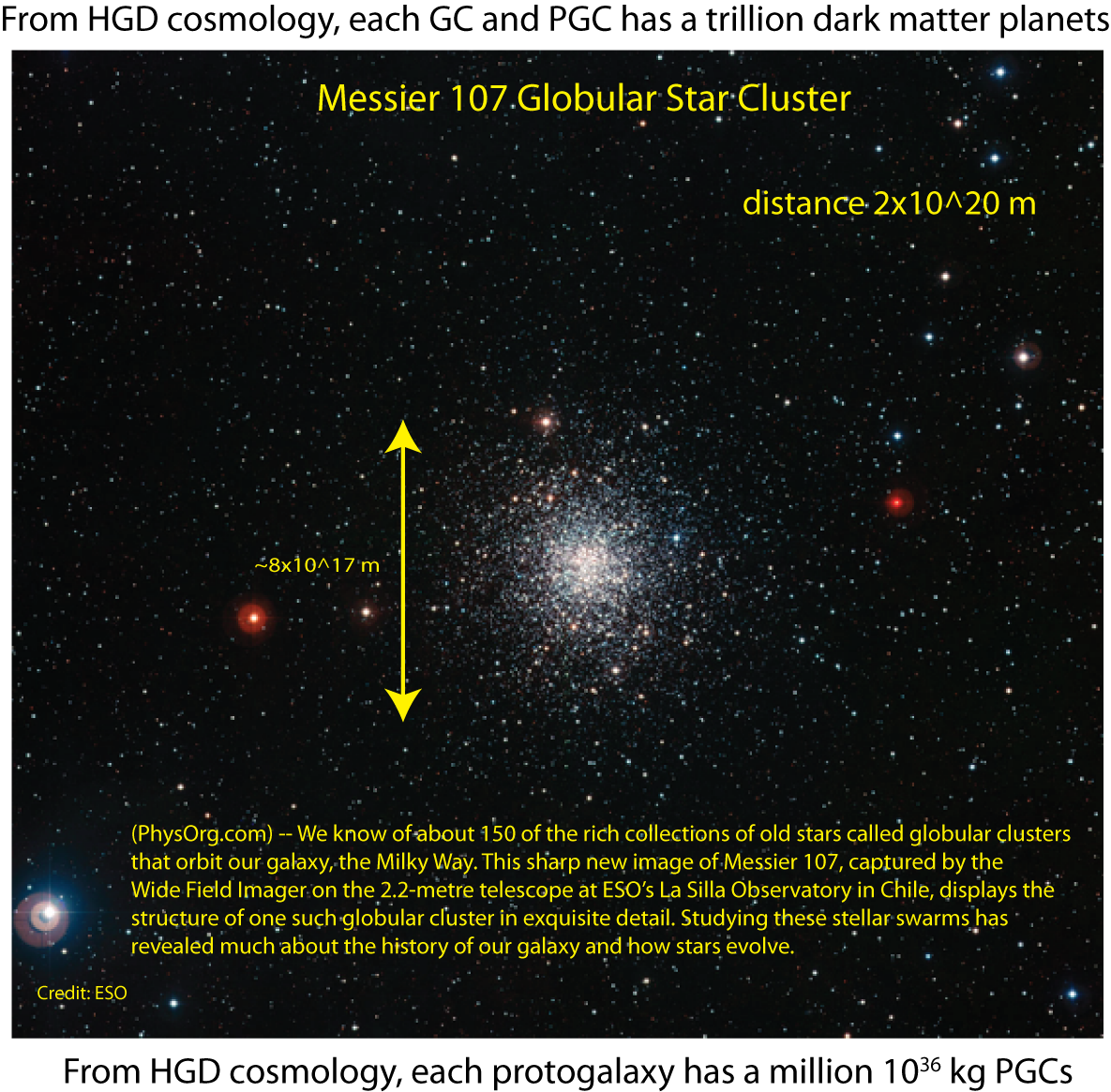
When the planets freeze the PGCs diffuse to form the nearly homogeneous pattern of GCs shown. The planets of the PGCs are in meta-stable equilibrium, permitting viscous interactions of PGCs as they diffuse from the protogalaxy core. Nonbaryonic dark matter and the mythological "CDM" have nothing to do with the patterns observed. Following is a quote from Schild (1996) where he suggests that planets comprise the dark matter of galaxies, confirming the hydrodynamic predictions of Gibson (1996) (CHG).
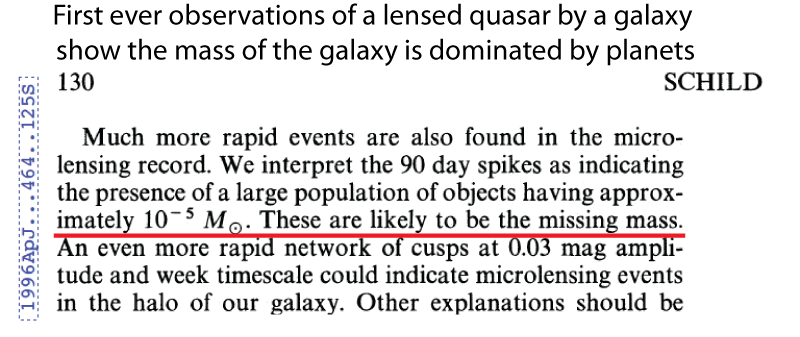
This proposal by Schild (1996) has been repeatedly confirmed and refined by subsequent observations of the same and other lensed quasars. Evidence that extremely hot hydrogen gas planets, stars, and supernovae existed ~ 10^12 seconds after the plasma to gas transition at ~ 10^13 seconds is provided by condritic meteorites.
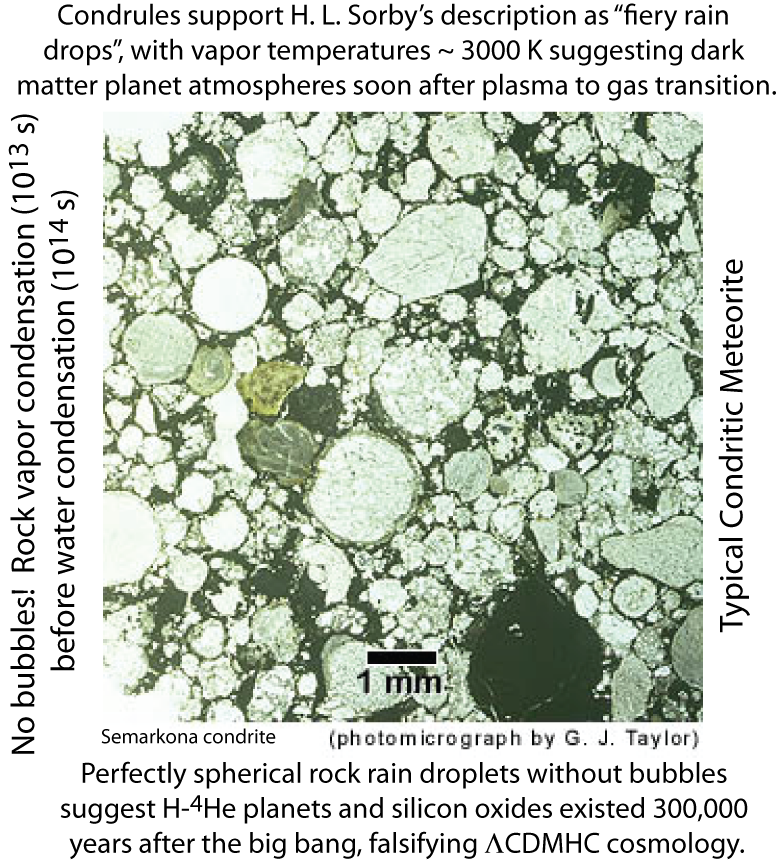
None of the condrules contain gas bubbles. This means they could not be created by ejection from the earth by impacts or volcanos. These fiery rock rain drops of H. L. Sorby (1877) are too large by a factor of a thousand to have been ejected from stars or by supernovae, and require the 3000 K atmospheres of dark matter hydrogen planets (10^13 seconds) before the condensation of water at 647 K (10^14 seconds). First stars and first supernovae at ~ 10^13 seconds readily explain these condrules, which are otherwise mysterious. Because such condrules are so common and so constraining, they falsify LCDMHC cosmology (CHG).
It is clear from the Harvard SIDM presentations and referenced papers that strong pressures exist to conform to the standard LCDMHC cosmological model, just as Hoyle and Wickramasinghe were pressured by editors and referees to conform to the terrestrial abiogenisis model for decades of their efforts to develop astro-biology. The result is censorship of new scientific ideas (CHG).
III. ASTROBIOLOGY
5. Biology Associated With A Titanium Sphere Isolated From The Stratosphere, Milton Wainwright, Christopher E. Rose, Alexander J. Baker, Raisa Karolla and N. Chandra Wickramasinghe, 11117-11125
6. Does a Supposed Volcanic Particle Mass Vitiate Claims that Biological Entities Arrive at the Stratosphere from Space?, Milton Wainwright, Christopher E. Rose, Alexander J. Baker, D. James Gilmour and N. Chandra Wickramasinghe, pp 11126-11130
7. Impact Events On A Graphite Stub Provide Evidence That A Biological Entity Arrived To The Stratosphere From Space, Milton Wainwright, Christopher E. Rose, Alexander J. Baker and N. Chandra Wickramasinghe, pp 11131-11136
8. Impacts of Cometary Meteoroids Bearing Biological Entities onto Surfaces in the Stratosphere, N. Chandra Wickramasinghe, Christopher E. Rose, Alexander J. Baker and Milton Wainwright, pp 11137-11141
9. Gil Levin to NASA: Release Evidence of Martian Life, Gil Levin, pp 11142-11145
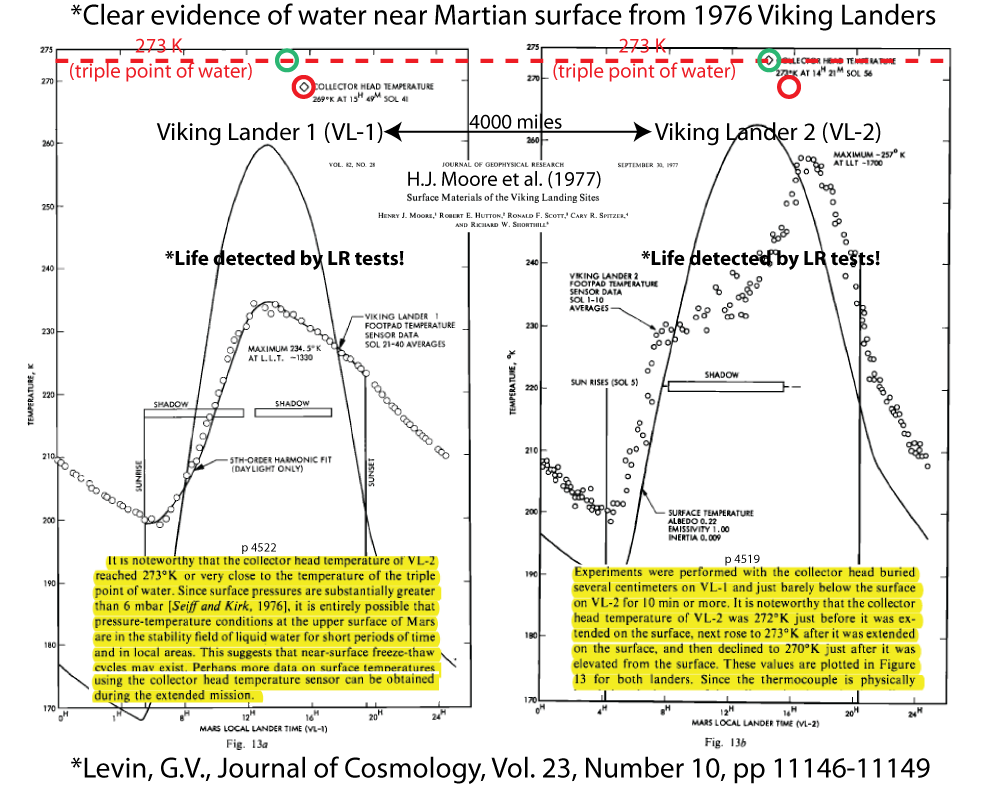
The "Labeled Release" test for life is quite simple and quite bullet-proof. Nutrients (mostly lactose) tagged with radioactive C-14 are provided to a sample of soil. The sample either releases radioactive gas from bacterial metabolism or it does not. Sterilized soil samples do not. Life contaminated soil samples do. Always. As shown in the Figure, life and water were detected in Martian soils near the surface by both of the widely separated VL-1 and VL-2 Viking Landers in 1976. A negative LR test was obtained by the Viking Landers for a sample of surface soil with positive LR test kept for three months in the dark at 10 degrees centegrade to make it sterile (CHG).
10. Will Curiosity confirm the 1976 evidence for life on Mars?, Gilbert V. Levin, pp 11146-11149
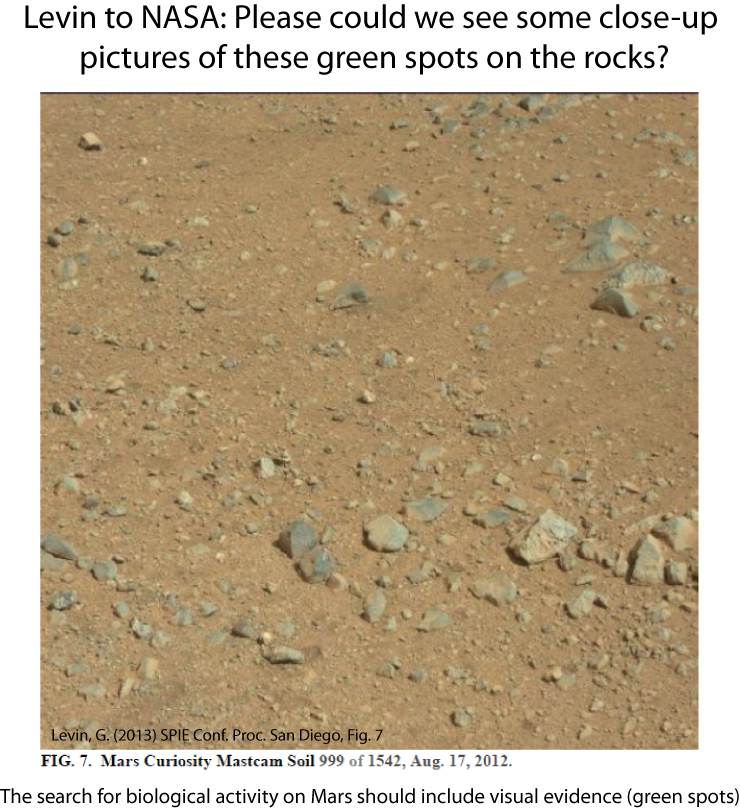
CBS interview of Prof. N. Chandra Wickramasinghe, who discusses the importance of the 1976 Viking Landers and the Levin Labeled Release experiments.
11. Turbulent mixing, viscosity, diffusion and gravity in the formation of cosmological structures: the fluid mechanics of dark matter, C. H. Gibson, astro-ph preprint of a Journal of Fluids Engineering (2000) article describes how dark matter planets in PGC clumps are formed at the plasma to gas transition, 30 million planets per star rather than only 8 or 9. pp 11900-11906. Explains the difference between condensation and fragmentation (highlighted).
12. Life begins on primordial dark matter planets, C. H. Gibson, Preprint of Life article, Jan. 6, 2014. 11908-11918.
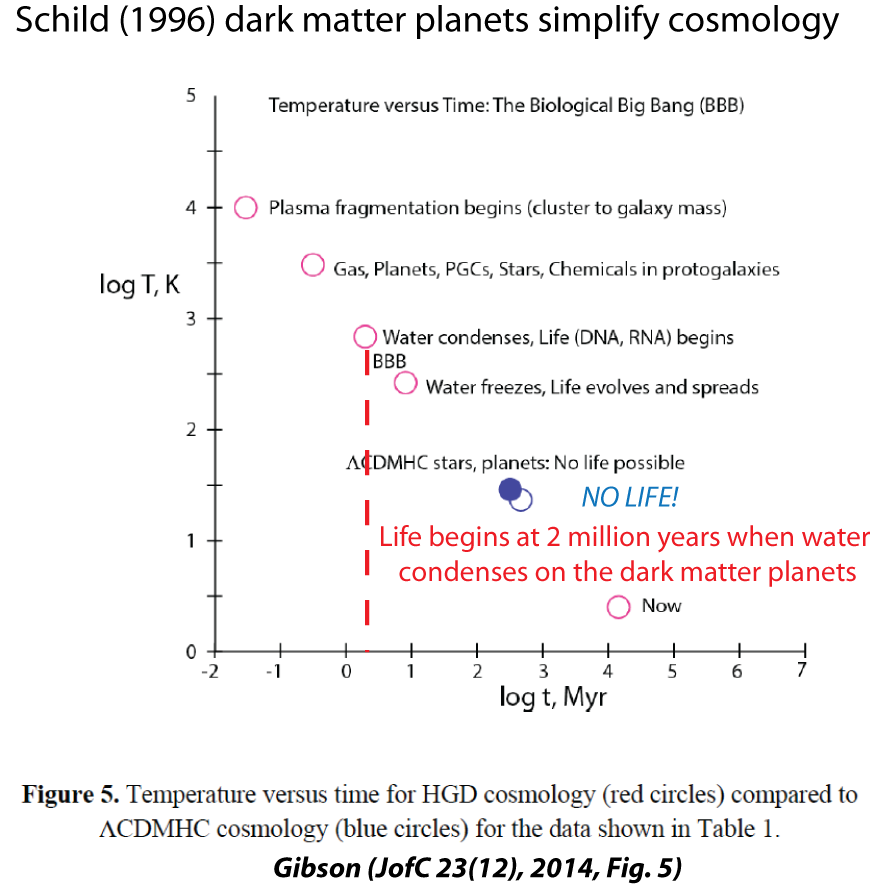
From this temperature versus time plot, we see that dark matter planets will begin to freeze solid at a few hundred million years. The large and small Magellanic cloud dwarf galaxies are massive clumps of PGCs with the 10^20 m size of the central protogalaxy, suggesting they are fossils of this object that diffused away when it began to freeze.
13. Is the Universe Simpler than LCDM?, Matthew G. Walker and Abraham Loeb, Preprint of Contemporary Physics article, Jan. 6, 2014. A valiant attempt is made in this paper by two top experts to salvage a failed and complex cosmology (LCDM). We suggest that cosmology, astrophysics and astronomy are vastly simplified by the collisional fluid mechanics of HGD cosmology. Astrobiology and astromedicine are impossible to understand otherwise (few planets, no life). In 292 references, no mention is made of the fact that life is impossible in LCDM cosmology. With millions of planets per star rather than a handful and deep hot water oceans on these merging planets fertilized by stardust, life in HGD cosmology is not only possible but simple and inevitable in its mechanism (CHG).
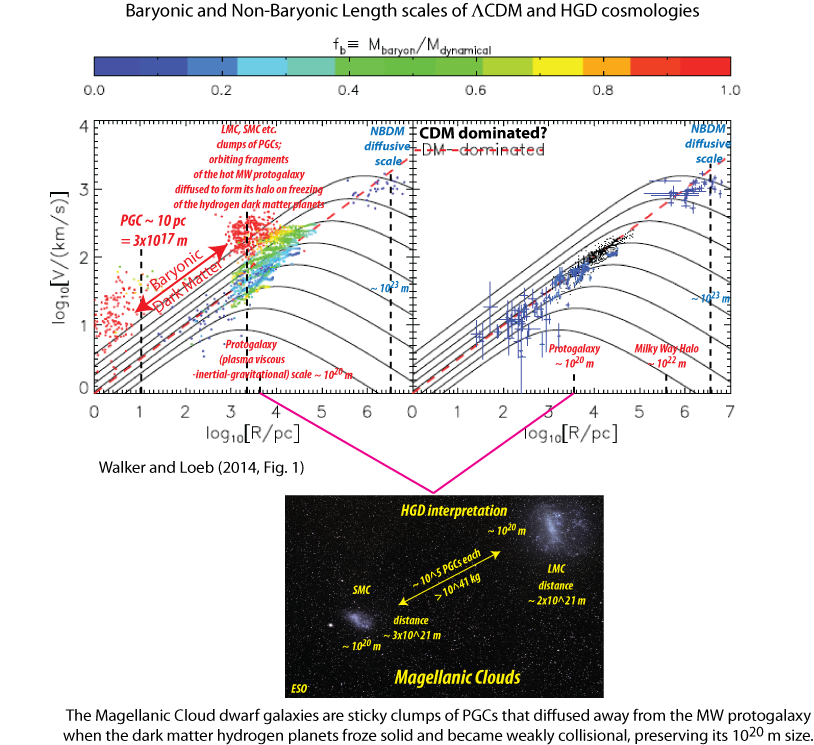
This figure (from Walker and Loeb (2014, Fig. 1)) compares length scales that emerge in LCDM and HGD cosmologies. Protogalaxies form at the Nomura scale ~10^20 m as the smallest scale objects of the plasma epoch, reflecting the Kolmogorov scale of the plasma since the plasma turbulence is weak and is suppressed by self-gravity and strong photon-viscous forces according to HGD cosmology, Gibson, Schild (1996). The LMC and SMC irregular dwarf galaxies have the same 10^20 m size, reflecting the freezing of hydrogen dark matter planets of the Milky Way protogalaxy that releases PGCs and PGC clumps to diffuse away and form the MW dark matter halo. The first objects to be released by this mechanism would be individual PGCs, eventually followed by large clumps of PGCs such as the dSph galaxies and the massive LMC and SMC irregular dwarph galaxies. The Non-Baryonic-Dark-Matter (NBDM) such as CDM diffuses to galaxy cluster halo scales ~ 10^23 m shown in blue (CHG).
14. The first turbulence, C. H. Gibson, astro-ph/0101061v5 preprint of Flow turbulence and combustion (2004) paper titled "The first turbulence and the first fossil turbulence". The paper was presented on the occasion of John Lumley's 70th birthday at Cornell University, and was dedicated to the memories of George Batchelor and Chuck Van Atta. pp 11150-11167
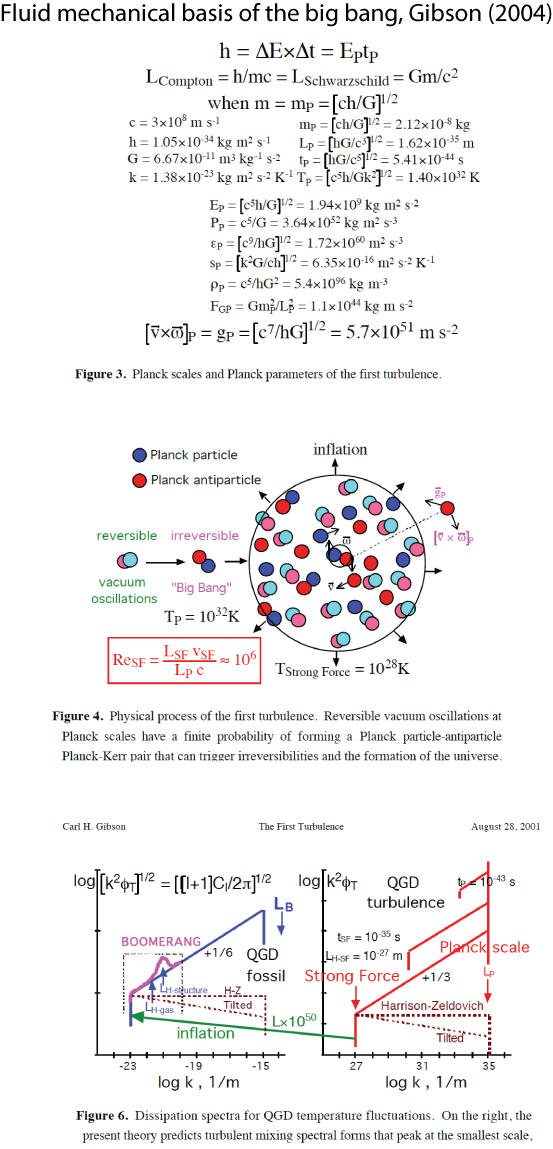
As shown in Fig. 3 of the paper, the big bang turbulence instability must occur at Planck conditions, where the only relevant dimensional parameters are the light speed c, Planck's constant h, Newton's constant G, and the Boltzmann constant k. Planck particles and antiparticles are the only ones possible, and form spinning pairs similar to positronium pairs in supernova II events, as shown in Fig. 4. From the Kerr metric, a prograde accretion of a Planck antiparticle on such a "Planckonium" pair can trigger the big bang event we live in, since 42% of of the rest mass energy of the antiparticle becomes available (Peacock 2000) to make more Planck particles. The spinning gas of Planck particles become turbulent. Turbulent negative stresses > c^7 h^-2 G^-1 ~ - 10^113 Pa (the Fortov-Kerr stress, or Fig. 3) cascade from small scales to large (with inflation to strong force freezeout when quarks and gluons appear and extract vastly greater amounts of mass-energy from the vacuum). Universal Kolmogorov turbulence similarity and Batchelor turbulent mixing similarity apply until gluon viscous stresses dominate after quarks become possible, as shown in Fig. 6. The first fossil turbulence appears when the turbulence scales exceed the "horizon" scale of causal connection ct. Fossil turbulence patterns are clear in the Planck collaboration CMB spectrum shown in the Frontispiece of this volume (CHG).
15. The first turbulent combustion, C.H. Gibson, astro-ph/0501416v2 preprint of Combustion Science and Technology (2005) article. pp 11168-11193.
This paper was dedicated to Professor Forman Williams on the occasion of his 70th birthday, and was edited with a collection of other such papers by Professor Norbert Peters. The time sequence of events from HGD cosmology is shown in Figures 5 and 6 of the paper.
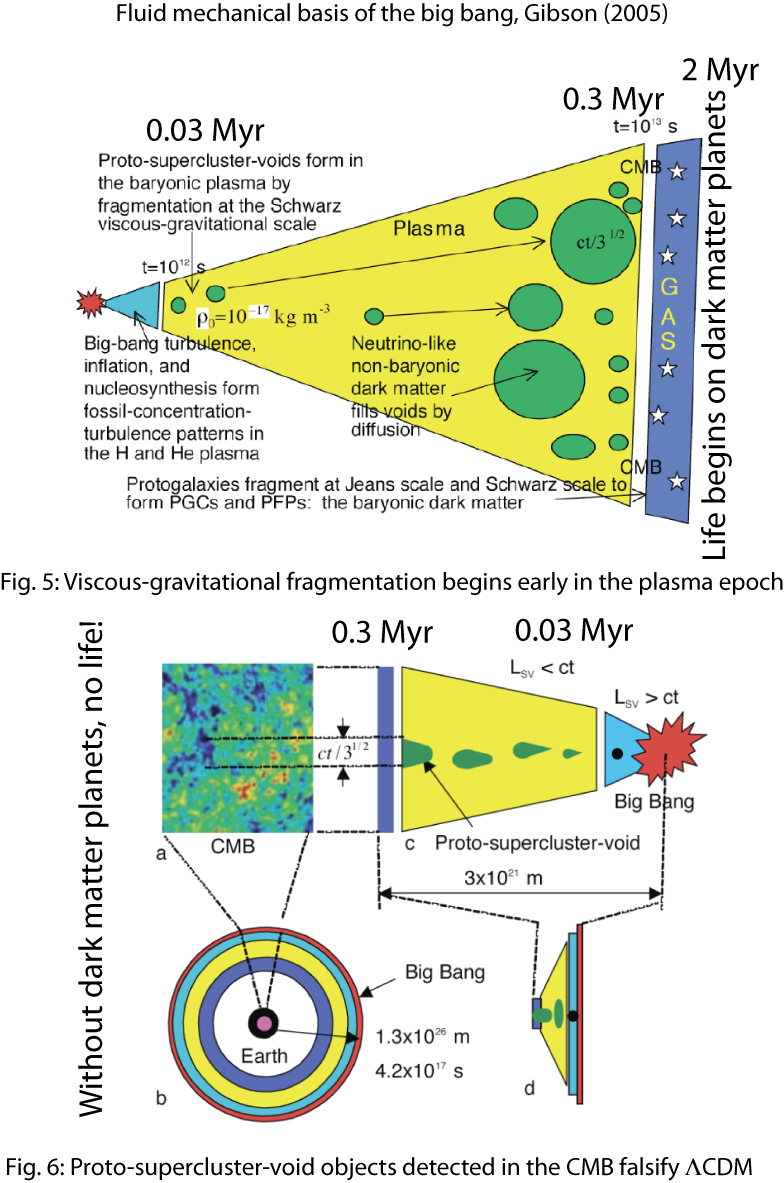
The viscous-gravitational fragmentation of the primordial plasma starts at 0.03 Myr (10^12 seconds). The fragments expand at sonic speed c/3^0.5 until the plasma-gas transition at 0.3 Myr (10^13 seconds) leaving cold spots with scales ct/3^0.5 visible on the Cosmic Microwave Background (CMB) images, as viewed from the Earth. Because the gas kinematic viscosity is smaller than the plasma kinematic viscosity by a factor of 10^13, the gas fragments to form dark matter Earth-mass hydrogen planets (Schild 1996). The planets fragment simultaneously within Jeans mass clumps of a trillion planets termed proto-globular-clusters (PGCs). Stars and star dust appear as the planets merge within the clumps and overfeed the stars, so that some of the stars explode. Life begins at 2 Myr when water condenses on the planets (647 K). The complexity of DNA-RNA life reflects the mixing of some fraction of the cosmic primordial soup of 10^80 planets and their oceans to form stars. The CMB objects falsify LCDMHC cosmology because supercluster scale objects should be the last, rather than the first, objects to form. Primordial Hoyle-Wickramsinghe cometary panspermia and cosmic homogeneity of life are supported as inevitable consequences of HGD cosmology (CHG).
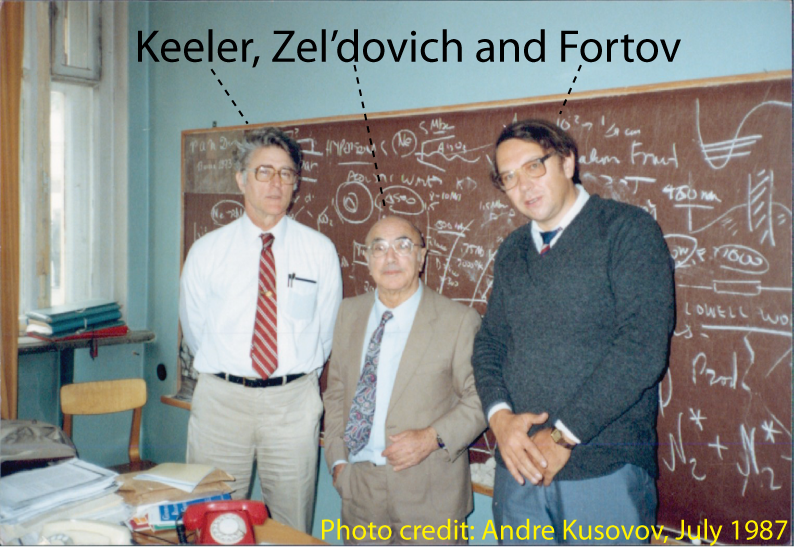
IAU 308 conference to honor Y. B. Zeldovich is planned in June 2014, Tallinn, Estonia. A technical biography of Academician Zeldovich by R. N. Keeler is provided, titled "The dynamic high pressure work of Academician Ya. B. Zel'dovich (1914-1987)", pp 11206-11216.
Further evidence (see Pittsburgh APS/DFD talk in Vol. 22, J of C) of accelerated O-B star formation rates on turbulent vortex lines is accumulating, where dark matter planets serve as fluid particles. The time to make a star is the gravitational free fall time of PGC dark matter planet clumps of a trillion planets, or only 30,000 years. By the standard star formation models from gas and dust the time is 6 Myr, larger by a factor of ~ 200. Inertial vortex forces of the turbulence triggers collisions and mergers of dark matter planets as they form stars. The stars tend to be bright O-B stars because the enhanced planet accretion rate mixes away the carbon core permitting oxygen, nitrogen, silicon, iron and nickel to form up to unstable star masses of ~ 1.3 solar (CHG).
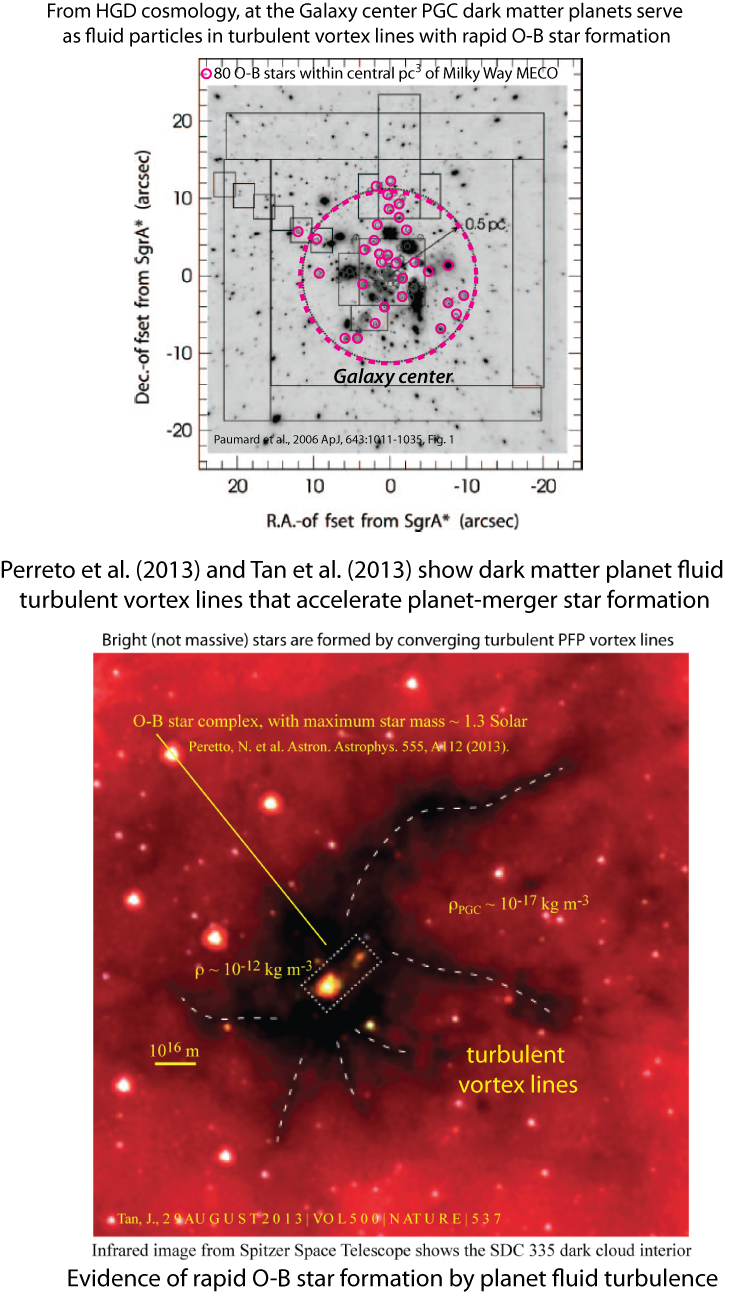
Fossils of the chemical composition of the universe following nucleosynthesis are provided by low metallically, low mass, dwarf stars, typically found in the Milky Way halo. These are formed by gradual mergers of pristine, metal free, dark matter planets in PGC clumps of a trillion according to HGD cosmology, so the planet material never gets hot enough to burn the lithium formed by nucleosynthesis as the first stars are formed. The primordial lithium abundance is frozen in when the temperature of the universe decreases to about 6,000 K at about 3 minutes after the big bang (see Steven Weinberg's famous book). If the first stars were formed according to LCDMHC cosmology they would be very massive and hot and would reionize all the baryons and burn up all the lithium, contrary to observations of the Spite plateau by Bonifacio et al. (2007), and predictions based on HGD cosmology. Population III stars (the first ones) were instead small dwarf stars formed from merging dark matter planets in their PGC clumps (not from gas and dust clouds). Thus, the Spite plateau falsifies the LCDMHC theory (CHG).
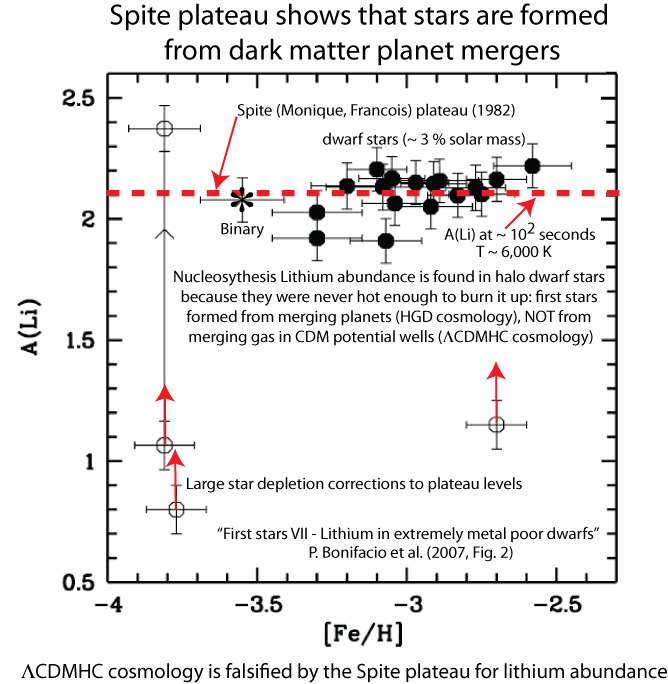
Further evidence of star formation from dark matter planet fluid is shown near the central Milky Way "black hole" or MECO object.
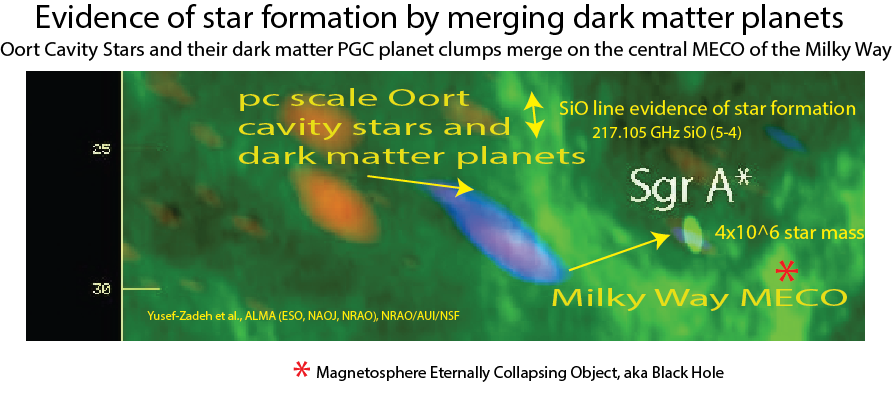
A four million solar mass (*Milky Way MECO) object much smaller than the PGC clouds in which it is embedded is triggering star formation by inducing star forming flows of dark-matter-planet fluid into the Milky Way MECO (CHG).
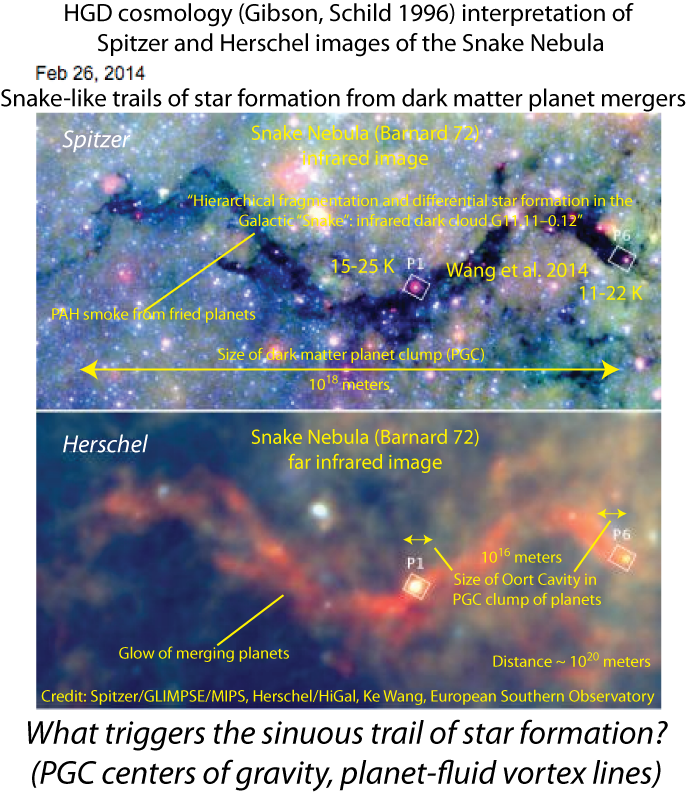
Evidence of star formation by dark matter planet mergers in PGC clumps is shown in Feb. 26, 2014 images from Spitzer (infrared) and Herschel (far infrared) space telescopes. The sinuous trail of star formation may result from a combination of random forces that trigger dark matter planet mergers. The stars produce opaque PAH (polycyclic-aromatic-hydrocarbon) dust as shown by the black snake of Spitzer (top). The red snake of Herschel (bottom) reflects the far infrared signature of planet mergers. Claims that these images show massive (> 1.44 Solar) Population III star formation are debatable. From HGD such stars become unstable and explode as SNIa for carbon core stars (>1.44 solar) or SNII for iron-nickel core stars (>1.3 solar). The Wang et al. (2014) claim (title) of "...hierarchial fragmentation..." (pc to 0.1 pc) is backwards from our HGD star formation scenario of planet mergers and cold cores at 0.1 pc Oort cavity scales (radius 3x10^15 m). Note that the temperatures in the P1 and P6 "cold cores" include the triple point 13.8 K expected for evaporating dark matter planets but not >30 K critical point values for hydrogen (CHG).
16. POLONNARUWA METEORITE AS PROOF OF EXTRATERRESTRIAL LIFE GETS SUPPORT AT PRESIDENTIAL LEVEL IN SRI LANKA, N. Chandra Wickramasinghe. pp 11194-11196.
A new website for Professor N. Chandra Wickramasinghe is https://profchandra.org/ .
17. A METEORITE FALL IN THE ANURADHAPURA DISTRICT OF SRI LANKA: EVIDENCE OF PUTATIVE BIOLOGICAL STRUCTURES AND THE RELEVANCE TO PANSPERMIA, A.D.M. Damayanthi, N.C. Wickramasinghe and K. Wickramarathne, pp 11197-11205.
Press Release for Anuradhapura Meteorite biological structures detection.
First reference in article 17 is The origin of life from primordial planets, Gibson, Schild, Wickramasinghe (2010), IJA preprint, pp 11208-11218.
18. The case for Equatorial Icing as the cause of Air France 447 and Malaysia Airlines MH 370 Catastrophies. Carl H. Gibson.
This paper has been moved to the Catastrophic Equatorial Icing-dedicated Volume 28